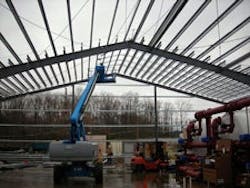Iron Removal Plant Replaces 80-Year-Old System in Maple Shade, N.J.
| Related Searches from WaterInfoLink.com Iron Removal | Layne Christensen | Maple Shade Township |
New Jersey’s Maple Shade Township has a population of more than 19,000. Water supplies for the township are drawn from a series of high-capacity wells that draw from the PRM aquifer. While Maple Shade’s history can be traced to 1682, a waterworks was not established until 1893. High iron concentrations subsequently led to the construction of an iron removal plant in the 1920s, which remained in service until June 2009. Now, a newly commissioned treatment plant is providing significant enhancements over its decades-old predecessor.
Maple Shade’s iron removal plant had clearly served far beyond its useful life. As originally designed, the plant relied on ion exchange for iron removal. A drawback to this design was the large volume of water wasted during system regeneration. For the system to regenerate, such high volumes of waste brine were produced that it caused upsets downstream at the wastewater treatment plant. With iron concentrations as high as 20 parts per million (ppm), a more efficient, less wasteful system was needed to treat and conserve the township’s water resources.
An outside consultant developed an RFP for the township based on the recommendation that the project be handled under a design-build contract. As a result, Maple Shade’s new treatment plant became the first design-build water treatment project completed in the state of New Jersey, and was funded by the State of New Jersey Environmental Infrastructure Trust Fund.
More than one hundred attendees were present at the pre-bid. Of all the bidding contractors, only Layne Christensen Co. was qualified to complete every major requirement of the project with its own forces.
In July of 2007, Layne was awarded a design-build contract to perform a month-long pilot study, propose a treatment strategy, design a treatment process and construct a 2,500–gal-per-minute (gpm) drinking water treatment plant, including all required infrastructure.
Construction
During construction of the new 3.3-million-gal-per-day (mgd) facility, Layne performed all sitework, including excavation and mechanical installation both above and below grade, all well redevelopment and abandonment, all carpentry and a portion of the structural concrete.
Treatment Technology
Layne based its treatment strategy on the iron levels found in the worst case of the three contributing wells. The completed system is capable of treating raw water with iron levels as high as 24 ppm. The treatment technology utilizes oxidation, precipitation and filtration to remove iron, manganese and solids . All pretreatment and filtration equipment was fabricated in Layne’s 20,000-sq-ft facility in Bridgewater, N.J.
The treatment strategy begins with a cascade aerator to promote oxidation and reduce CO2. Lime is added in a flash mixer to control pH and to further reduce CO2, and chlorine is added as an oxidant. The water then flows to a slow-mix flocculation tank where a low dose of polymer is added. The resulting floc particles are then removed through gravity settling in an inclined plate clarifier/settler.
Sludge produced during flocculation is recirculated to the flash mixers while the partially treated water is evenly distributed to four multimedia pressure filters, each containing anthracite, sand and gravel. The pressure filters remove any remaining solids and automatically perform air scour and backwash cycles, triggered by differential pressure buildup.
The plant is completely automated with options for semi-automatic and has the ability to run in full manual mode if necessary. The pretreatment system was designed and built to enable a complete shutdown of one treatment train by closing valves that isolate the second treatment train. This enables the plant to produce 1,250 gpm while one train is out of service.
Maple Shade’s new treatment plant is truly a “green” facility. The treatment technology was selected in part on energy requirements. All of the filter backwash is recycled to minimize wasting water. Solar collectors help control energy costs while reducing the plant’s carbon footprint. The solar collectors were approved and funded by the New Jersey Environmental Trust Fund.
In July 2009, the plant went online and has been performing satisfactorily within design parameters.
